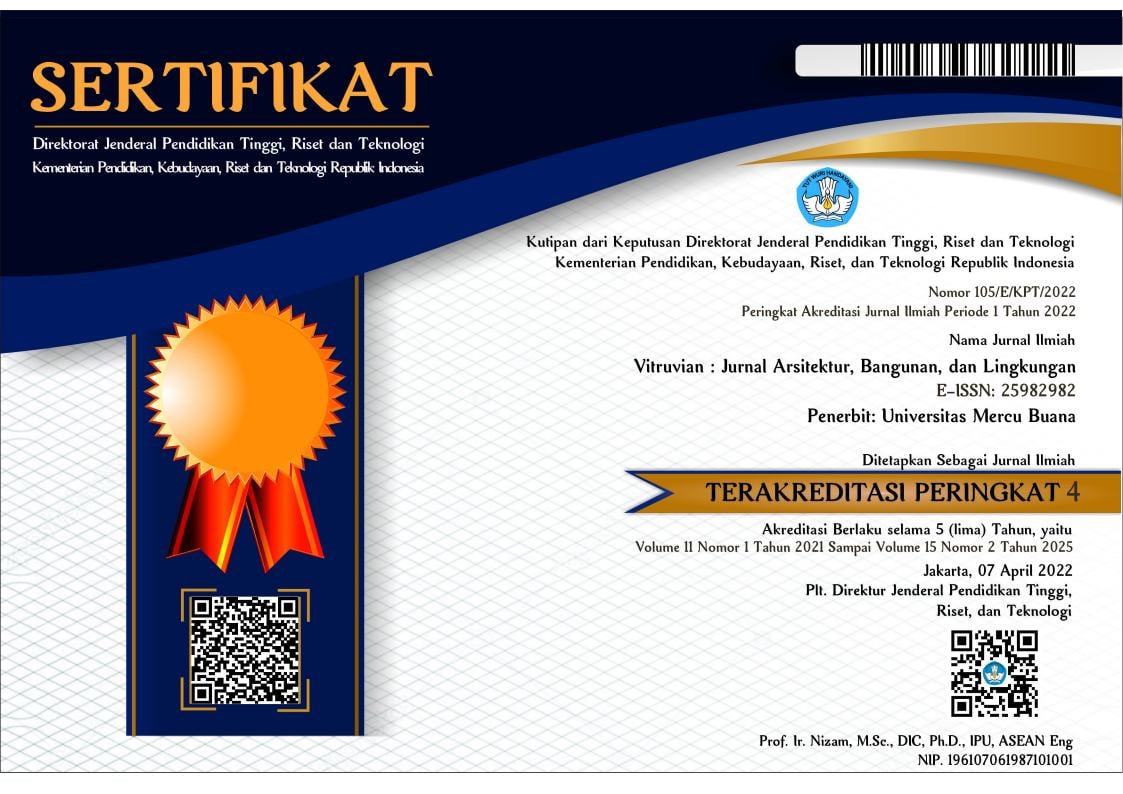PERSEPSI PENGGUNA TERHADAP TEMPAT YANG DIHINDARI DALAM MENGURANGI PENYEBARAN VIRUS
Abstract
Wabah COVID-19 telah menyebar hampir keseluruh dunia dan telah ditetapkan sebagai darurat kesehatan masyarakat dunia oleh WHO. Untuk mengurangi risiko penyebaran virus ini pemerintah berupaya melakukan pembatasan di berbagai daerah. Selain itu masyarakat yang mengetahui bahaya tertularnya virus mulai menghindari tempat-tempat yang memiliki risiko penularan yang besar. Kondisi bangunan saat ini menjadi hal yang penting untuk mengurangi kekhawatiran dalam mengunjungi tempat umum, terlebih bila tempat tersebut tidak memiliki kriteria bangunan sehat. Penelitian ini dilakukan untuk mengetahui penilaian bangunan dari perspektif pengguna. Metode penelitian yang digunakan adalah kualitatif dengan pendekatan grounded theory berupa pengumpulan data menggunakan kuesioner daring yang bersifat terbuka, analisis yang dilakukan berupa open coding, axial coding, dan selective coding. Hasil penelitian yang didapat adalah perspeksif pengguna berupa tempat yang dihindari dan alasan pengguna menghindari tempat tersebut. Hasil berupa empat kelompok utama yaitu kelompok minim prokes, kelompok risiko tertular, kelompok menghindari virus dan kelompok kurang nyaman. Hasil penerapan empat kelompok tersebut berupa penyesuaian desain dan perilaku dalam merancang bangunan sehat yang terhindar dari virus. Diharapkan penelitian ini dapat menjadi pertimbangan dalam membangun bangunan sehat, selain untuk kenyamanan pengguna, penerapan ini dilakukan agar bangunan tersebut dapat beradaptasi dengan kasus pandemi dikemudian hari.
The COVID-19 outbreak has spread in almost all parts of the world and has been declared a world public health emergency by the WHO. To reduce the risk of the virus spreading, the government is trying to make restrictions in various aspects. At the same time, people who know the dangers of this virus begin to avoid places that have a high risk of contagion. Healthy buildings are now crucial because nowadays conditions (pandemic) make public awareness raises, especially when these places -in a visual way- do not seem to have health criteria, which makes the public worried more. This research is done to know the requirement of the building from the perspective of the user. The research used qualitative with a grounded theory approach in the form of data collection using an open online questionnaire, and the analysis is carried out in the form of open coding, axial coding, and selective coding methods. The research results are get from respondents perspectives in the form of places to avoid including the reasons, the groups acquire are the less-acknowledged health protocol group, the group which has infected risk, the group who try to avoid the virus, and the less-comfort group. The results of the application of the four groups are in the form of design and behavior adjustments in designing healthy buildings that are protected from viruses.This research is expected to be a reference for designing a healthy building. Besides for the convenience of users, this implementation is also expected could make the building adapt to this kind of case such as the pandemic in the future.
Keywords
Full Text:
PDF (Bahasa Indonesia)References
Covaci, A. 2020. How can airbone transmission of COVID-19 indoors be minimised?. Environment International, 142 (April), 1-7.
Creswell, John, W. 2007. Qualitative Inquiry and Research Design: Choosing Among Five Approaches. California: Sage Publications, Inc.
Creswell, J. W. 2008. Research Design: Qualitative, Quantitative, and Mixed Methods Approaches. California: Sage Publications, Inc.
Creswell, J. W. 2012. Educational research: Planning, conducting, and evaluating quantitative and qualitative research (4th ed.). Boston: M.A. Pearson.
Dietz, L., Horve, P. F., Coil, D. A., Fretz, M., Eisen, J. A., & Van Den Wymelenberg, K. (2020). 2019 novel coronavirus (COVID-19) pandemic: built environment considerations to reduce transmission. Msystems, 5(2), e00245-20.
Kemenkes. 2020. Protokol Kesehatan Bagi Masyarakat Di Tempat Dan Fasilitas Umum Dalam Rangka Pencegahan Dan Pengendalian Corona Virus Disease 2019 (Covid-19). HK.01.07/Menkes/382/2020.
Khan, A. H., & Karuppayil, S. M. (2012). Fungal pollution of indoor environments and its management. Saudi journal of biological sciences, 19(4), 405-426.
Kurnitski, J. et al. 2020. REHVACOVID-19 Guidance Document.
Takewaki, I. 2020. New Architectural Viewpoint For Enhancing Society’s Resilience For Multiple Risks Including Emerging COVID-19. Front. Building Environ. 6, 143.
Magdalena, E. D., & Tondobala, L. 2016. Implementasi konsep Zero energy building (ZEB)dari Pendekatan Eco-Friendly pada Rancangan Arsitektur. Media Matrasain, 13(1), 1-15.
Pakasi, T, A. 2020. Pentingnya Pengendalian Udara Lingkungan Untuk Pencegahan Transmisi SARS CoV2. CoMPHI Journal: Community Medicine and Public Health of Indonesia Journal. Vol. 1, No. 2.
Rahayu, R. L., & Lutvaidah, U. Persepsi Pemilik Rumah Sederhana Sehat (RSS) Menuju Rumah Sehat Nyaman Tipe 36.Rahim, M. 2015. Bentuk Dan Karakteristik Rumah Tradisional Jepang. Proc. Senarigti LPPM Unkhair, 2015, 1(1), 49-56.
Rahim, M. 2015. Bentuk dan Karakteristik Rumah Tradisional Jepang. Proc. Senarigti LPPM Unkhair, 1 (1), 49-56.
Rahim, M. 2021. Implikasi Covid-19 Terhadap Bangunan dan Lingkungan. Jurnal Sipil Sains. Vol. 11 No. 1.
Ratnasari, A. 2021. Aspek Kualitas Udara, Kenyamanan Termah Dan Ventilasi Sebagai Acuan Adaptasi Hunian Pada Masa Pandemi. Jurnal Arsir Universitas Muhammadiyah Palembang.
Rudi Purwono, R. 2020. Kajian Adaptasi Disain Arsitektur Setelah Masa Pandemi Covid-19. Adaptasi Disain Arsitektur Dan Arsitektur Lanskap Dengan Adanya Kehidupan Sosial Baru Setelah Pandemi COVID-19.
Weber, T. P., & Stilianakis, N. I. 2008. Inactivation of influenza A viruses in the environment and modes of transmission: a critical review. Journal of infection, 57(5), 361-373.
WHO. 2020. Coronavirus Disease (Covid-19) Pandemic. World Health Organization, Geneva.
Yuliana. 2021. Bangunan Ideal Untuk Mengurangi Risiko Transmisi Covid-19. Border Jurnal Arsitektur, Vol. 3 No. 1.
Zarrabi, M., Yazdanfar, S. A., & Hosseini, S. B. 2021. COVID-19 and healthy home preferences: The case of apartment residents in Tehran. Journal of Building Engineering, 35, 102021.
DOI: http://dx.doi.org/10.22441/vitruvian.2022.v12i1.006
Refbacks
- There are currently no refbacks.
Copyright (c) 2022 Vitruvian : Jurnal Arsitektur, Bangunan dan Lingkungan
License URL: http://publikasi.mercubuana.ac.id/index.php/virtuvian/article/view/15510
Layout Jurnal Vitruvian:Download
Declaration & CTA Form Vitruvian:Download
(WAJIB DI UPLOAD SEBAGAI SUPLEMENTARY SAAT SUBMIT ARTIKEL)
Vitruvian
Program Studi Arsitektur
Fakultas Teknik Universitas Mercu Buana
Jl. Raya Meruya Selatan, Kembangan, Jakarta 11650
Tlp./Fax : +62215871335
Surel : [email protected]
p-ISSN : 2088-8201
e-ISSN : 2598-2982
Website : http://publikasi.mercubuana.ac.id/index.php/virtuvian
DOI : 10.22441/vitruvian
Vitruvian is indexed by the following abstracting and indexing services:

This work is licensed under a Creative Commons Attribution-NonCommercial 4.0 International License.








